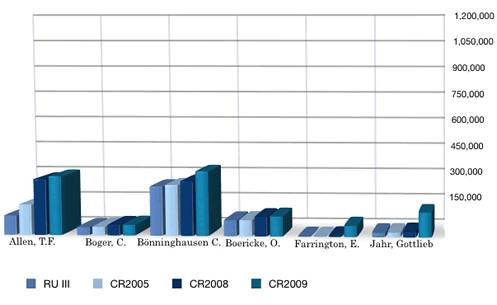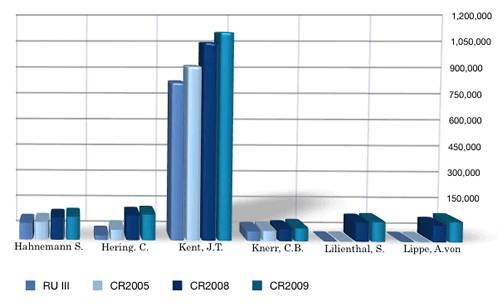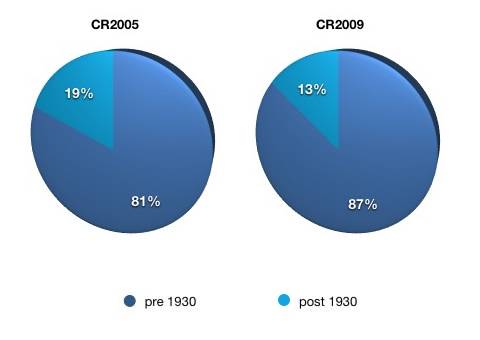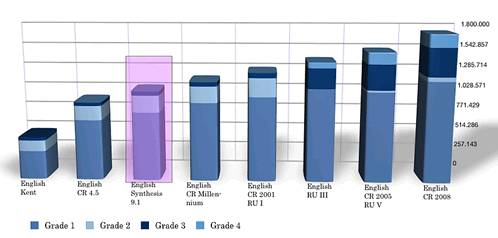The Complete Repertory is a standard reference source, being one of the two principle modern repertories in daily use by homeopaths all over the world, and has been translated into several languages. Based on Kent’s Repertory, it has been extensively revised, corrected and updated through several editions and incorporating material from materia medica and many other repertories.
In its latest 2009 edition it contains more than 1.9 million remedy additions in over 178,000 rubrics. The new Complete Repertory features the changes to the remedy grading system that were introduced in the Repertorium Universale, and benefits from the extensive revision and increase in number of cross-references between rubrics undertaken for the introduction of this repertory. (See Repertory Guide for further details.)
Since the release of the Complete Repertory 4.5, an additional 52,500 rubrics and 981,300 remedy additions have been made.
- Authors profile
- Structural changes
- Repertory grade comparisons
- Latest additions
- Comparisons with previous edition and Synthesis 9.1
Authors profile
An enormous amount of work during the last 4 years has gone into integrating the important sources of the past into the Complete Repertory. The percentage of material from old sources (pre-1931) has been substantially increased with additions from the likes of T F Allen, Jahr, Farrington, etc. (See also the Top 12 Complete Repertory 2009 Authors below). There have been criticisms that modern repertories feature too many additions from modern sources. These statistics here show this is not the case.

| Author additions |
Pre 1930 |
Post 1930 |
Total |
| CR 2005 | 1,807,537 | 410,303 | 2,217,840 |
| CR 2008 | 2,453,116 | 590,285 | 3,043,401 |
| CR 2009 | 2,978,355 | 460,688 | 3,439,043 |
(NB. CR 2008 statistics are anomalous due to some errors in the Bibliography that attributed post-1930 dates to pre-1931 material.)
Some authors, like Hahnemann, Boger, Kent and Knerr, who where already well represented in the last four versions of the Complete Repertory/Repertorium Universale, have seen their additions increase gradually, while authors like Allen, Jahr, Farrington and Lippe have increased substantially due to the inclusion of all second degree and higher symptoms from Allen’s Encyclopedia, Jahr’s Symptom Codex (still in progress), Farrington’s Clinical Materia Medica, all repertory work in Lilienthal’s Homeopathic Therapeutics, all material out of Lippe’s (Bannerjea’s) Keynotes and Redline Symptoms, and (nearly) all Lippe’s articles. All these sources have considerably increased the amount of clinical verifications (ie. 3rd and 4th degree additions).


| Author |
RU III |
CR 2005 |
CR 2008 |
CR 2009 |
| Allen, T F | 105,890 | 166,395 | 306,192 | 323,043 |
| Boger, C M | 43,869 | 46,422 | 56,371 | 58,298 |
| von Boenninghausen, C F M | 269,663 | 278,117 | 298,449 | 353,470 |
| Boericke, Oscar | 87,060 | 88,650 | 106,523 | 109,818 |
| Farrington, E | 929 | 920 | 3,986 | 60,312 |
| Jahr, Gottlieb | 23,980 | 25,140 | 28,514 | 135,710 |
| Hahnemann, S C F | 89,029 | 94,521 | 118,229 | 124,639 |
| Hering, C | 23,737 | 54,632 | 131,787 | 138,173 |
| Kent, J T | 841,372 | 927,639 | 1,053,359 | 1,108,694 |
| Knerr, C B | 50,879 | 53,509 | 61,516 | 69,573 |
| Lilienthal, S | 125 | 160 | 101,398 | 105,111 |
| von Lippe, A | 688 | 722 | 86,077 | 106,833 |
Structural Changes
For 2008, some structural changes were made to the repertory. After working on the Repertorium Universale structure for quite some years and seeing that most people do not understand it, or for various reasons do not want to work with it, it was time to go back to the more Kentian version: Complete Repertory. In order to make the information easier to access the following structural changes were made:
- The “Ailments from” rubrics were rearranged under the Mind section. Previously some of these (e.g. Anger, vexation agg., Anguish agg., Anticipation, foreboding, presentiment agg. and Anxiety agg.) were contained in the Generalities section.
- In the extremities section all specific localisations under “Upper limbs” and “Lower limbs”, i.e. upper arms, elbows, ankles, feet, etc., were moved up a level in the hierarchy. You can now open Extremities; Pain and go directly to feet, or hands, etc. That means a lot of rubrics have become much more easy to reach, being less deeply embedded in the hierarchy of the repertory.
- Similarly, in the Mind Section, body parts in Delusions were moved up a level from the ‘body parts’ subrubric, e.g. Delusions; body; body parts; hands becomes Delusions; body; hands. This is also the case with body parts in the Dreams section.
- Mind Section rubrics featuring animals in Fears, Dreams and Delusions were moved up a level in the hierarchy so that, for instance, Fear; animals; dogs becomes Fear; dogs.
- In the main rubrics of all sections the generalised modalities were merged with the phenomena. In CR2005 there were sometimes long listings of generalised modalities before the list of phenomena, and many users would like to see the phenomena more directly. Therefore I have merged them and, when the first word of the modality was the same as the first word of the phenomenon, I have made the modality a sub-rubric of the phenomenon, thus emphasizing the phenomenon a little bit more. For example, instead of having two entries for Activity, the first a modality and the second a phenomenon, both the modalities and phenomena attributable to Activity are now listed under the one rubric.
- The specific tastes, discolourations and smell/odours were taken out of their main rubrics when appropriate and moved up a level in the hierarchy, enabling the user to go to a specific discolouration, taste or odour directly.
- In Speech & Voice, the main rubrics now begin with the descriptive term, e.g. Speech, awkward becomes Awkward speech.
Repertory Grade Comparison from Kent’s to Complete Repertory 2009
Click on graph to see larger image. Click again to toggle off.
Originally the third degree was the highest degree available in my repertories, an inheritance of Kent’s grading system. On top of these was later added a fourth degree, inheritance of Pierre Schmidt. I am convinced P Schmidt’s fourth degree is actually the same as Boenninghausen’s fourth degree (fifth degree when you count the zero degree in Boenninghausen as the first) and therefore in later versions of my work this P Schmidt degree is amalgamated with the fourth degree of Boenninghausen. This change took place in CR2001. Starting with RU III in this graph the Boenninghausen degree system is used. The second degree now expresses the information found in provings and available from two or more provers, enabling us to have a more pronounced analysis of especially those often new remedies that would otherwise be ‘flat’, not expressing any addition in the repertory in any degree but the lowest.
Latest additions
In the Complete Repertory 2009, some of the lesser known remedies have gained more than 30% new third or fourth degree material (compared to Complete Repertory 2008): coll. ferr. ferr-pic. ham. benz-ac. symph. bar-m. usn. hippoz. quarc. titan. crot-c. nast. cror-r. chim. prun. kali-ar. card-m. ars-i. seneg. aethi-m. myrt-c. salv. aur-m. merc-d. iris mag-p. cupr-acet. lac-d. cimx. pareir. uva petros. lac-c. lec. ol-sant. (see Bibliography for full list):
Comparisons with previous edition
|
CR 2008 |
CR 2009 |
|
| Number of author sources | 1,196 | 1,318 |
| Number of author sources more than Synthesis 9.1 |
310 |
432 |
| Remedy additions more than Kent | 1,245,192 | 1,410,791 |
| Remedy additions more than CR 2005 | 211,384 | 376,983 |
| Remedy additions more than CR 2008 | 165,599 | |
| Remedy additions more than Synthesis 9.1 |
681,350 |
1,666,316 |
| Author occurrences more than Kent | 2,540,256 | 2,936,624 |
| Author occurrences more than CR 2005 | 830,645 | 1,221,929 |
| Author occurrences more than CR 2008 | 391,284 | |
| Author occurrences more than Synthesis 9.1 |
1,275,032 |
1,440,631 |
| Remedies with more than 50% new information (compared to CR2005) | 160 | |
| New remedies (compared to CR2005) | 89 | 89 |
For latest updates about Complete Repertory, please visit http://www.morphologica.com/








a best try in homoeopathy